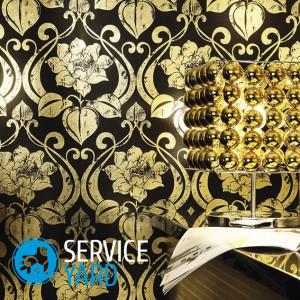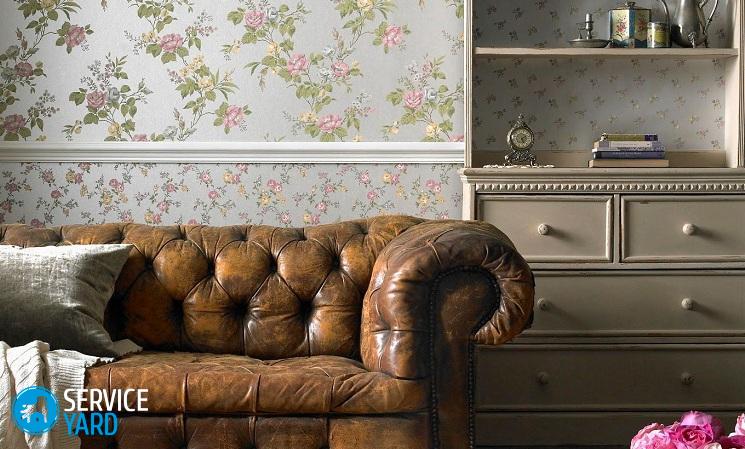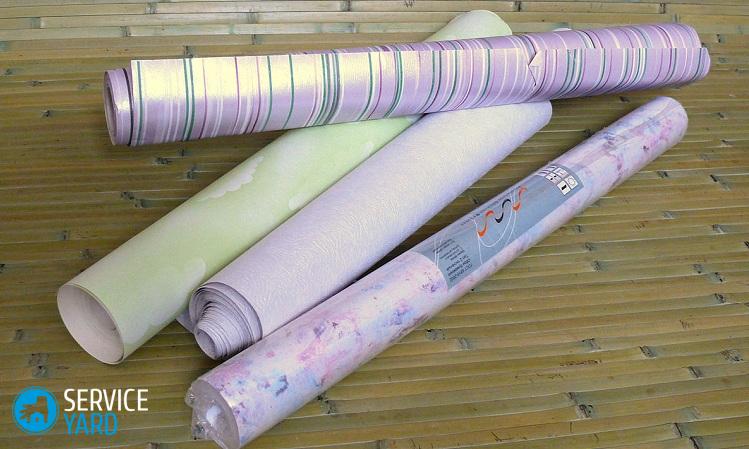Is it possible to glue vinyl wallpaper on non-woven glue?

Every person throughout his life is faced with such a specific process as apartment renovation. It can be produced for several reasons. First of all, each of us sometimes wants to change a boring interior, and in this case, you can get by with simple cosmetic work in the form of wall decoration and changing furniture. And you can start a major overhaul with the demolition of the walls and significant changes in the situation. In any case, at the finish stage you can not do without wallpapering. And here, sooner or later, the question arises: is it possible to glue vinyl wallpaper on non-woven glue? Let's try to figure this out.
to contents ↑Adhesive Features
Paper wallpapers have not lost their popularity, despite a wide selection of other, more modern rolled materials. But the glue that was used a few years ago is no longer so interesting to customers.
The specialized composition was developed specifically for gluing non-woven wallpaper with a new method - by applying directly to the wall surface, which greatly simplifies the work. Also, the following characteristics can be attributed to the advantages:
- Possibility of quick application with a special brush or roller during self-decoration of walls.
- Excellent sliding ability, providing an easy joint of the panels.
- Wallpaper gluing speed.
- Lack of reaction with the coloring matter after drying.
- Absolute safety for the health of people living in the house.
- Prevention of fungus due to bactericidal and antifungal additives.
Wallpaper
In order to understand the question of whether it is possible to glue vinyl wallpapers on a paper basis on non-woven glue, it is worthwhile to find out what materials are generally offered by building stores. Let's start with the wallpaper.
Non-woven wallpaper:
- This web material is made from cellulose fibers with additives of certain components. This makes the wallpaper environmentally friendly.
- They perfectly let air in, allowing the walls to “breathe”.
- Non-woven roll material is characterized by good strength and high density. They are perfect for uneven walls, because the texture of the material allows you to hide all the flaws.
- Another plus (due to its special density) - under the influence of glue, which mainly consists of water, non-woven is not deformed. Unlike thin paper material.
- It is non-woven wallpaper that is recommended for the decoration of newly constructed buildings, which have not yet completed the process of general shrinkage.
- An undoubted advantage for consumers is that this rolled material is very easy to use. During gluing, these wallpapers do not shrink after drying, do not stretch, and only the surface of the walls is smeared with glue.
Important! It is also worth knowing the main disadvantage of this roll material. It can not be called budget. And there is a simple explanation for this. Wallpaper that are on Russian shelves or brought from abroad, or made from imported raw materials.
Vinyl wallpapers
Now let's move on to a careful study of vinyl wallpaper:
- This roll material consists of two layers. The top is a polyvinyl chloride film, it protects the wallpaper from moisture and possible damage. The lower part is a paper or non-woven backing.
- Vinyl, due to its density, like non-woven, perfectly hides surface defects and is suitable for imperfect walls. They can also be washed; the top PVC film can withstand the moisture test. If you competently exploit this rolled material, then they will last you a very long time.
- Another plus is the special impregnation of wallpaper. It is made with the use of antiseptic emulsions and thanks to this, mold can be avoided.
Important! We can not say about the shortcomings. PVC film, which protects against moisture, also does not let air through. For rooms with high humidity, sticking them is not recommended, since under the roll material in this case there is a high probability of dampness and fungus.
Differences
To understand whether it is possible to glue vinyl wallpaper on non-woven glue, let's figure out what the difference between these materials is:
- The most important difference is the ability to pass air. Non-woven wallpapers earn a plus here. Vinyl, which is covered with a film, put a minus.
- Non-woven and vinyl materials differ in the way they are glued. If, when working with the former, it is enough to lubricate only the surface of the wall, then when gluing vinyl, heavier wallpapers, glue processing of roll material is also required.
Paper wallpaper
Wallpaper made of paper can be safely called a long-liver - no matter how they try to force them out of the market of finishing materials with other, more modern coatings, this does not work. They have quite a few advantages:
- A huge plus this material has earned due to its environmental component, because paper is a wood processing, which does not even have adhesives in its composition, not to mention chemical additives.
- Working with them is simple and familiar to everyone.
- To remove paper wallpaper from the wall, if you decide to change the interior, also does not present any special difficulties. Soaked and scraped with a spatula.
- Paper can breathe - pass moisture through its pores and allow it to go into the wall. Under such conditions, fungal and mold microorganisms are not able to survive behind the wallpaper.
But along with a large list of advantages, paper wallpapers have a sufficient number of disadvantages:
- It is impossible to wash or clean them - any attempt to do this leads to paper soaking, and as a result - to damage to wallpaper.
- Very short life. Even the highest quality paper wallpapers are not able to last more than 10 years.
- If we talk about the effect of environmental factors on paper wallpapers, then here they are not up to the mark - almost all varieties of this material burn out under the influence of sunlight.
Wallpaper glue
Glue for light paper wallpapers is the most common and budget option. If you have just such rolled material, then questions should not arise. But, in order to understand what is still to choose, let's dwell in more detail on the adhesive compositions.
Non-woven glue
Non-woven glue, as the name implies, is designed for pasting non-woven wallpaper. It consists of the main component - modified starch, to which methyl cellulose and antiseptics are added. On store shelves it is presented in the form of powder:
- In order to obtain a composition for pasting, the powder should be diluted in cold water.
- All manufacturers indicate the proportions of the main components on the package without fail.
- The glue diluted with water is left to infuse for 10-20 minutes, while constantly stirring.
- The consistency of the finished glue should resemble sour cream, without lumps.
- On the surface of the rolled material, the composition must be applied in a uniform layer to avoid un-glued areas.
Important! A feature of non-woven glue is its tolerance and resistance to absolutely any paint, on whatever basis they are made.
Vinyl glue
Its main feature is versatility.With it, you can work with corrugated, smooth wallpaper, as well as with rolled material with embossing and silk screening.
Vinyl glue for the most part also consists of starch. But to it add special vinyl compounds. It is these compositions that facilitate the wallpapering process, they simply glide along the wall. It is very convenient when the strip is not light upright.
to contents ↑Important! Manufacturers also produce a special composition of vinyl glue, which includes fiberglass and velor. These components provide strength and protect the material from moisture.
Is it possible or not?
Now that we have figured out all the components and raw materials that are used for the production of wallpaper and glue, we can safely answer all questions related to the repair. So:
- Is it possible to glue vinyl wallpaper on non-woven glue? You can, because the basis of the adhesive compositions is a modified starch, which is suitable for both non-woven and vinyl. One thing: if this type of glue got on the front side of the roll material, then it should immediately be removed with a clean, dry cloth.
- Is it possible to glue paper-based vinyl wallpapers on non-woven glue? Here the answer is also quite simple. It is possible, and even necessary, because this type of wallpaper is dense, consists of two layers, so it is also heavy. Since non-woven adhesive has special adhesive properties, it can withstand such a weight.
- Is it possible to glue paper wallpaper with non-woven glue? If you still have stocks of adhesive non-woven composition from previous repairs, then you can safely use it in working with paper roll material. You just need to add a little more water, and paper wallpaper requires a light solution.
- Is it possible to glue non-woven wallpaper with vinyl glue? Here, too, the answer is yes. Both non-woven and vinyl roll materials are heavy, and starch-based glue will provide strong and reliable adhesion to the wall. The only caveat - in this case, glue should not be applied to the wallpaper, only on the surface of the wall.
to contents ↑Important! For pasting any type of wallpaper, you can use the simplest composition based on starch or flour. Improving it a bit with the addition of building PVA. The folk method, working, tested by many years of practice.
Glue consumption
When the main issues are resolved, do not rush to run to the hardware store. To begin with, it is worth calculating how much powder you need. Of course, each manufacturer provides the packaging with detailed instructions on the method of preparation, use and calculation, but there are some basic indicators:
- For ordinary paper wallpapers, you will need from 70 to 80 g of the finished composition per 1 square meter of area for the primer, and from 42 to 48 for gluing.
- For vinyl wallpaper, the calculation is as follows: 70 to 80 grams of the mixture per 1 square meter of area for the primer, and from 28 to 34 for gluing.
- Textile and texture wallpaper is heavier, and therefore the powder consumption will increase. For the primer, about 90 grams will be required, and for gluing - from 32 to 38.
Important! Please note when choosing that such special formulations usually have the prefix “Super” or “Premium” in the name.
- Popular non-woven wallpaper on a smooth basis will require from 30 to 32 grams of composition per square meter, and embossed wallpaper from 25 to 30. For primer, you need to take a paste at a rate of 70 g per square.
- Cullets themselves have good adhesion to any surface, and therefore, for priming the walls under them, you need a smaller amount of mixture, it is enough to apply 50 g per square, and for gluing use 25-30 g.
to contents ↑Important! These calculations are useful not only to save your own money. When applying a larger amount of the composition, lumps and wet bubbles often form, which ultimately affects the appearance. And the average calculation of the flow rate will help to understand whether you are overdoing it or better to use a little more glue.
Stock footage
The wide variety of offers that are available on the market today makes it possible to select the glue you need for almost any kind of canvas. And this question is solved quite simply. It is not difficult to choose the adhesive composition in the presence of certain knowledge that you received from this article.
- How to choose a vacuum cleaner taking into account the characteristics of the house and coatings?
- What to look for when choosing a water delivery
- How to quickly create comfort at home - tips for housewives
- How to choose the perfect TV - useful tips
- What to look for when choosing blinds
- What should be running shoes?
- What useful things can you buy in a hardware store
- Iphone 11 pro max review
- Than iPhone is better than Android smartphones





